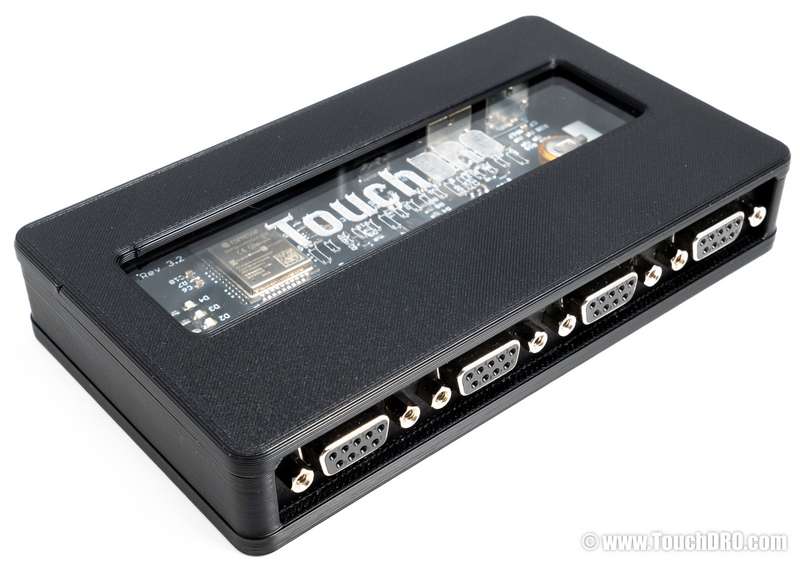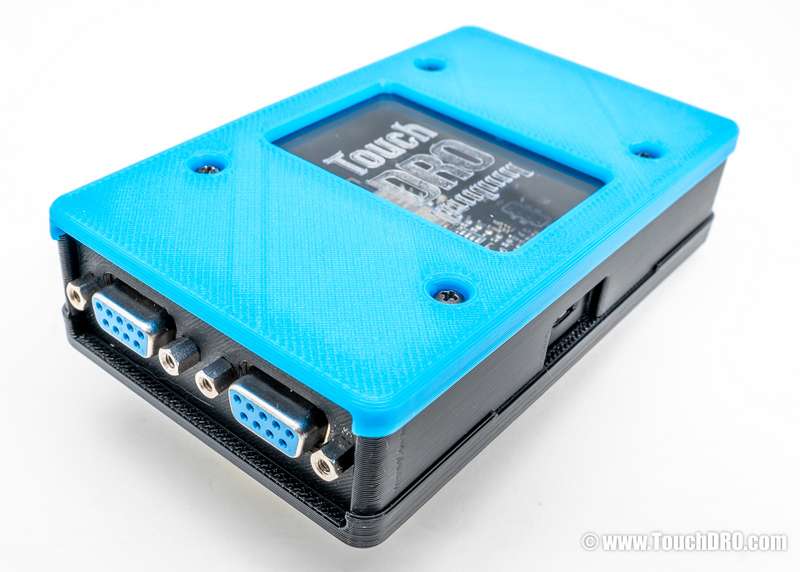TouchDRO Adapter Feature Comparison
The current generation of TouchDRO scale interface adapters consists of two families:
- TouchDRO TDA-400 and TDA-420 adapters are optimized for professional use and are packed with advanced features.
- TouchDRO TDK-40 and TDK-40T do-it-yourself adapter kits are designed to be budget-friendly and easy to build.
Both families are based on the same powerful dual core 32-bit microcontroller and run the same version of the core firmware. All adapter models come with four high-speed differential scale inputs that work with single-ended (5V TTL) and differential (RS-422) quadrature encoders. This includes the majority of modern optical and magnetic DRO scales, as well as NPN, PNP, and push-pull rotary encoders.
Adapter Features
| TDA-420 | TDK-410 | TDK-40T | TDK-40 | |
|---|---|---|---|---|
 |
 |
|||
| Comes fully assembled. Learn more | Requires some soldering and mechanical assembly. Learn more | |||
| Best For | Milling Machine | Metal Lathe | Milling Machine or Lathe | |
| Inputs | ||||
| Total Inputs | 6 | 4 | 4 | |
| RS-422/Differential Inputs | 4 | 4 | ||
| TTL/Single Ended Inputs | 2 1 | 1 | 0 | |
| Reference Track Support | Yes 2 | No | ||
| Serial Protocol Decoding | Mitutoyo SPC, BIN6 3 | No | ||
| Tachometer Input | 1 1 | 1 | 1 | 0 |
| Probe/Height Setter Inputs | 2 1 | 0 | 0 | 0 |
| Limit Switch Inputs | 4 1 | 2 1 | 0 | |
| Connectivity | ||||
| Bluetooth | Yes | Yes | ||
| USB | Full Time | When Bluetooth is connected | ||
| Other Features | ||||
| TouchDRO Version | TouchDRO Plus | TouchDRO Basic | ||
| Power Loss Position Retention | Yes | No | ||
| Over-the-Air Updates | Yes | No | ||
| Warranty | 5 years | 1 year | ||
1 The flexible TTL inputs can be user-configured as a combination of up to one/two encoder inputs (TDA-410/420), pair of probe inputs (TDA-420), tachometer input, or one or two pairs of limit switch inputs (TDA-410/420).
2Requires DRO scales with a compatible reference track.
3Requires a compatible signal converter module.
Technical Characteristics
| TDA-420/410 | TDK-40/P/T | |
|---|---|---|
| Position Refresh Rate | 25Hz | |
| Supply Voltage | 5V-5.5V | |
| Max Current Draw | 300mA | |
| Firmware Family | ESP32 V3 Pro | ESP32 V3 Lite |
| Primary Scale Inputs | ||
| Input Lines per Axis | A, A', B, B', R/Z, R'/Z' | A, A', B, B' |
| Encoder Support | PNP, NPN, Push/Pull | |
| Supply Voltage | 5V | |
| Min Signal Voltage | 1.8V | |
| Max Signal Voltage | 5V | |
| Max "Low" Signal Voltage | 1.2V | |
| Min "High" Signal Voltage | 3.6V | |
| Max Input Frequency | 1MHz | |
| Min Edge Separation | 250ns | |
| Glitch Rejection | Yes | |
| Reference Trigger Latency | 2 µs | N/A |
| Aux. Axis Inputs | ||
| Input Lines per Axis | 2a | 1b |
| Encoder Support | NPN, Push/Pull | |
| Supply Voltage | 5V | |
| Min Signal Voltage | 2V | |
| Max Signal Voltage | 5V | |
| Max Low Signal Voltage | 1V | |
| Pull up/down | Pulled up to 5V | |
| Max Quadrature Frequency | 100KHz | N/A |
| Min Quadrature Edge Separation | 5 µs | N/A |
| Glitch Rejection | No | N/A |
| Tachometer Pulses/Second | 0.5-40,000 | |
| Max Probe Latency | 2 µs | N/A |
| Max Limit Switch Latency | 2 µs | N/A |
Parameter Explanation
Position Refresh Rate
This is the frequency at which the given adapter sends the value to the application when the axis is in motion. For instance, the adapter from glass/magnetic scales will send the position 25 times per second, while the other two send the value only 10 times per second.
Max Frequency
Highest quadrature signal frequency that the input will be able to process; higher is better. Exceeding this frequency will lead to missed pulses. For example, a 1-micron scale moving at 1 meter per second will have quadrature frequency of 250KHz.
Min Edge Separation
Minimum pulse width that the adapter will register; lower is better.
Tachometer Pulses Per Second
This is the number of pulses per second the tachometer can recognize reliably. For instance, when a single mark encoder disk is used, the tachometer will read between 30 RPM and 600,000 RPM (1 pulse every 2 seconds to 10,000 pulses per second); with a disk that has 10 marks, the supported RPM range will be between 3RPM and 60,000 RPM.
Probe and Limit Switch Trigger Delay
This is the amount of time the adapter will take to capture the position after the probe or a limit switch is engaged. Lower is better. This is proportional to the potential digital "backlash" in the system. For instance, when the axis is moving at 1mm per second, 1µs delay will result in potential error of 0.000001mm; 100ms will result in 0.1mm potential error.
Max Signal Voltage
This is the highest safe signal level that can be applied to the given input. Voltage that is higher than the indicated level will quickly permanently damage the input and the board will need to be repaired.
Min Signal Voltage
This is the lowest voltage level that will be recognized by the given input. Any value above this level (up to the max voltage) will be treated as a logical 1.
Max Low Signal Voltage
This is the highest voltage level that will still be recognized as a logical 0 when the signal is going from high-to-low.
